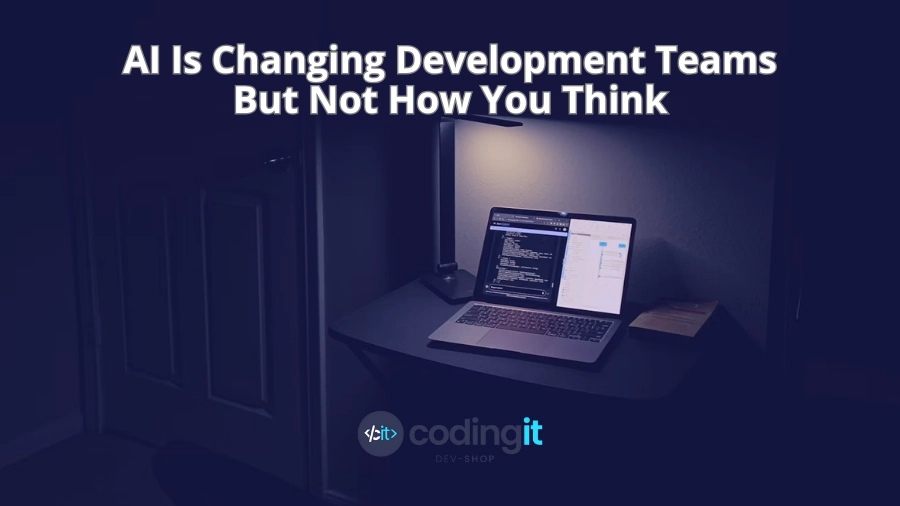As it has always been, developers are still solving problems. But since AI entered their daily tasks, they’ve been doing them alone. That quiet shift is happening across software teams, and most companies haven’t even noticed yet.
Ask yourself: when was the last time a junior developer pinged a teammate with a technical question? When did you last hear two engineers debating a solution instead of silently refactoring in parallel? Those moments are happening less and less. Not because the problems disappeared -we don’t think that will ever be the case- but because the process of solving them changed.
AI tools like ChatGPT, Copilot, and countless LLM-powered assistants have become the first place developers turn to. They’re fast. They’re available 24/7. They don’t need context or backstory. And, to be frank, they often give a decent enough answer to unblock whatever you’re working on.
From a productivity angle, it’s a dream. Developers no longer have to interrupt others. They don’t have to admit they’re stuck. They don’t have to feel like they’re asking a “dumb” question. They can move forward without friction.
The problem is that removing friction doesn’t always make the process better. It just makes it quieter. Companies are starting to confuse silence with efficiency. Collaboration is being replaced by independence. Mentorship is being replaced by autocomplete. And that would be fine if software development were just about getting answers.
But it’s not. It’s about context. Tradeoffs. Architecture. Standards. Growth. All things that don’t live in a one-line answer from an LLM.
This shift isn’t breaking anything overnight. That’s exactly why it’s dangerous. It’s happening in the background, one skipped question at a time, until you realize your dev team doesn’t really talk anymore. Just because they got used to not needing each other. And that’s not just a change in workflow. That’s a culture change.
Blog Summary:
As AI tools become part of everyday workflows, dialogue is being lost. We’re not here to panic. We’re here to show you:
- How AI is subtly changing the way developers solve problems.
- Why fewer questions don’t mean fewer problems.
- The risks of letting code quality and architectural standards drift unnoticed.
- How developer growth stalls when feedback fades out.
- What leaders may be unintentionally signaling through silence.
- Practical ways to build collaboration.
- What kind of team culture supports long-term product quality.

Table of Contents:
The Lost Art of Asking for Help
Every developer was once a junior. Every senior got there by asking questions. Constantly. And in high-functioning teams, asking wasn’t a vulnerability, it was the norm. But that norm is breaking.
With AI always ready, many developers no longer see the point in reaching out. It’s faster to prompt a model than to explain the problem to a teammate. It’s “safer”, too. I mean, for their ego. No fear of judgment, no delay, no need to admit you’re stuck.
Over time, that behavior starts to change the way teams operate. People stop asking, so people stop offering. Mentorship fades. Peer reviews become shallow. Second opinions get replaced by autogenerated confidence.
The most concerning thing is that teams stop developing shared understanding. There’s no alignment on why decisions are made, how architecture is evolving, or what trade-offs are being accepted by default. AI gives you code but not context. And context is what keeps a team building together, not just in parallel. Without cohesion, you just have individuals committing code into the same repo.
When Ideas Go Unchecked
Coding without asking questions means making decisions alone. Small ones, at first. But they stack up quickly. And while we encourage independence, we don’t look for isolation.
Without team input, those one-off choices about structure, dependencies, naming conventions, or logic flow start to shape the entire system. There’s no debate, no second layer of thinking, no shared vetting process. Just execution.
This results in a codebase that reflects individual reasoning instead of collective understanding. You’ll see five different ways of handling the same pattern. Utility functions that overlap. Design choices that only make sense to the person who wrote them. And that’s assuming the person even remembers why they did it that way and didn’t just rely on a bit of vibe coding to get it done.
It’s not about bad intentions or bad developers. It’s about missing friction. The good kind. The kind that forces people to explain themselves, rethink solutions, and align with the rest of the team.
When ideas go unchecked, they might look like progress. But underneath, they introduce complexity, inconsistency, and silent misalignment.
When Teams Stop Growing
Not every developer needs to be a system architect. But every developer should be growing. Sharpening their thinking. Building technical depth, not technical debt. Understanding the why, not just the what.
The problem is that growth comes from struggle. From asking questions. From explaining ideas. From getting things wrong and being shown a better way. AI is removing a lot of that.
It turns struggle into suggestion. It fills in the blanks without requiring understanding. It offers a shortcut. And people tend to take it. Not because they’re lazy, but because it works. Until it doesn’t.
Over time, this creates teams that can ship features, but not scale systems. Developers who can deliver tasks, but not lead projects. Teams that look productive on paper, but aren’t maturing under the surface.
And when your team isn’t growing, your capacity for complexity stalls. Your ability to onboard new people slows. Your senior engineers become the bottleneck. And no amount of AI suggestions will fix that.

When “Good Enough” Becomes the Bar
If you have talked to an AI (who hasn’t?) you know it doesn’t push for excellence. It optimizes for completion. It gives you what you asked for, not necessarily what you need. And when teams rely on it too heavily, that mindset starts to seep into the way software is built.
Does the answer look correct? Good enough. Does it pass the tests? Good enough. No one pushed back on the PR? Ship it. Without critical feedback, without teammates challenging ideas or refining decisions, “good enough” becomes the standard by default. Because no one decided otherwise.
That’s how quality starts to degrade. There’s no dramatic drop in performance, just a slow accumulation of safe decisions, shallow solutions, and missed opportunities to do better. Eventually, you end up with a product that technically works, but lacks polish, consistency, or long-term stability.
This is the risk when teams replace collective thinking with automated answers. Not only do they stop asking if something works, they stop asking if it should exist in the first place. Tools don’t care about quality. People do. And if your team isn’t actively keeping that standard alive, no one else will.
Leaders Set the Standard
The behaviors developers adopt aren’t random. They reflect what the environment rewards. If speed is praised but thoughtfulness goes unnoticed, guess which one people will choose. If no one asks questions in code review, why risk being the one who slows things down?
Leaders don’t need to explicitly say “don’t collaborate” for a culture of silence to form. It happens by omission. When there’s no space for conversation, when feedback isn’t modeled, when mentoring isn’t valued, people get the message: stay in your lane, finish your tickets, and move on.
And when AI enters that environment, it accelerates the problem. It makes it even easier to avoid human interaction. To look productive. To get things done without ever surfacing uncertainty.
If you’re leading a team, you can’t afford to be passive about this. Because what you don’t say becomes the standard. What you don’t question becomes the norm. And once “just ship it” becomes the unofficial motto, it’s hard to walk it back.
Do you want teams that think, challenge, and grow? Then reward the behaviors that lead there. Make room for them. Model them yourself. Because AI might be changing how developers code but it’s leadership that shapes how they build.
Collaboration Now Needs To Be Designed
Most teams assume collaboration is something that just happens. You hire good people, give them tools, and trust they’ll talk when they need to. That used to work, but the environment changed.
Remote setups made everything async. AI tools removed the need to ask questions. And now, developers can go from ticket to pull request without speaking to a single person all day. This is not a warning, it’s a reality.
If your team still relies on “reach out if you need help,” you’ve already lost. Collaboration now needs to be engineered into the process. Built into rituals. Backed by systems. This means designing workflows where interaction isn’t optional.
Like pairing by default. Code reviews with actual discussion. Knowledge-sharing sessions that aren’t filler meetings. Async threads with real engagement, not emoji reactions. And feedback loops that include context, not just green checkmarks.
It also means being intentional with AI. Use it, sure, that is almost inevitable. 3 in 4 coders have tried AI. But review its output together. Ask what it missed. Don’t just accept the suggestion, interrogate it as a team. You don’t have to over-process collaboration. But if it’s not in the structure, it won’t happen. Not anymore.
The Way Forward
AI has changed how developers code, and it also has to change how teams operate. Incorporating AI is just like incorporating any tool in your workflow, it should be done with careful consideration of motivations, desired outcomes, and within your ability to grade the success or failure of the outcome.
If you cannot confidently grade the quality of the outcome, find a trusted partner (cough cough, like us) who can not just clarify your goals and define Objective Key Results, but facilitate the change that enables your organization to be emboldened by AI, not a slave to its tooling or marketplace of ideas.
Collaboration, mentorship, and growth will no longer happen if we do not wake up to the reality that companies are now disincentivized to hire junior talent.
This isn’t about banning AI. It’s about making sure your teams don’t lose the habits that make software work at scale. That’s why at CodingIT, we embed full, collaborative teams that know how to deliver and how to talk. We bake in feedback loops, code reviews with actual feedback, and intentional knowledge-sharing. Our engineers work as part of your system, not just inside your repo.
Because great software doesn’t come from silence. It comes from structured collaboration, thoughtful challenge, and a team that’s aligned on more than just velocity. If that’s the kind of team you want to build, let’s talk.
